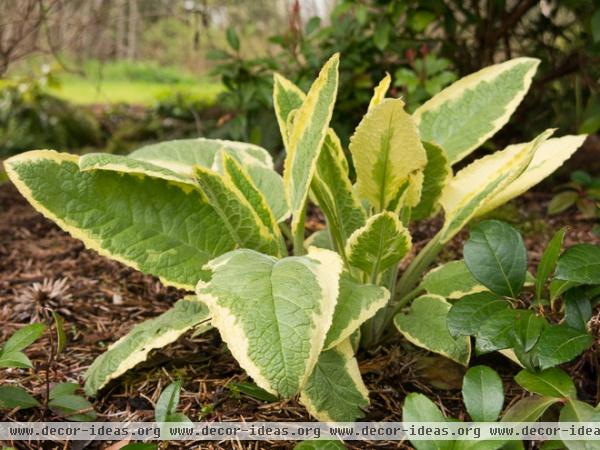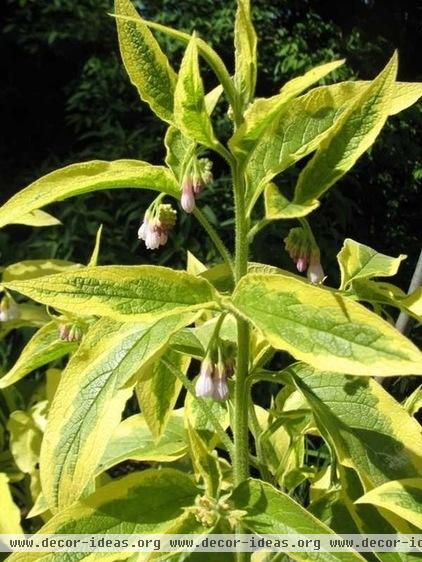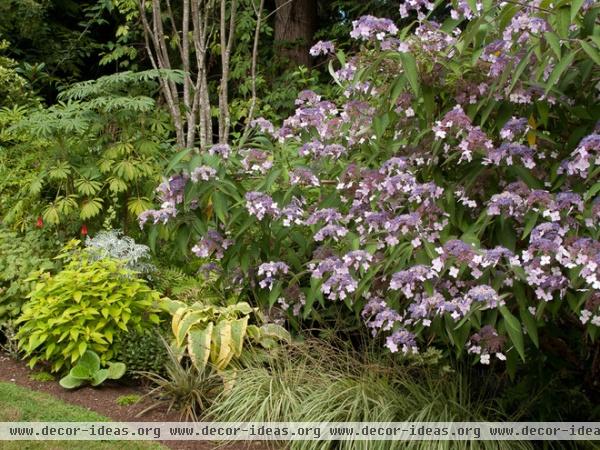Great Design Plant: Axminster Gold Comfrey for Sun or Shade
http://decor-ideas.org 05/13/2014 03:24 Decor Ideas
There aren’t many plants that have good looks in both sun and shade, so when I discovered this boldly variegated perennial, I was excited to experiment with it in my garden. At first glance it could be mistaken for a hosta, but its coarse, somewhat hairy leaves indicate it is a member of the borage family (unlike with hosta, the deer leave it alone).
This vigorous grower might be too aggressive for some, but in my Seattle garden I appreciate its tenacity and have plenty of space for it to grow.
Caution: Comfrey may be invasive in your area. Check with your local cooperative extension or county extension office before planting.

Botanical name: Symphytum x uplandicum ‘Axminster Gold’
Common names: Gold variegated comfrey, Axminster Gold comfrey, Russian comfrey
Origin: A naturally occurring hybrid found in the Caucasus Mountains in Eurasia between the Black Sea and the Caspian Sea
Where it will grow: Hardy to -30 degrees Fahrenheit (USDA zones 4 to 7; find your zone)
Water requirement: Average
Light requirement: Full sun to partial shade (does best protected from hot afternoon sun in warmer climates)
Mature size: The foliage rosette is typically 18 inches tall and 2 feet wide, but the flower spikes may rise to 4 feet.
Benefits and tolerances: Deer resistant; rabbit resistant (so far in my garden); attracts butterflies
Seasonal interest: Spring through fall
When to plant: Spring or fall

Distinguishing traits:
Attractive variegated foliageSoft pink bell-shaped flowers in June and July

How to Use It
Mixed borders: The photograph here shows how beautifully Axminster Gold comfrey can be incorporated into a garden border. The bold leaves provide contrast with the delicate grasses, while the yellow variegation wakes up the otherwise muted tones.
Woodland gardens: Allow it to naturalize in the dappled woodland shade, where it will add a bright note amid ferns, coral bells (Heuchera) and bleeding heart (Dicentra spectabilis).
Cottage gardens: Traditional English cottage gardens include a seamless melding of ornamental flowers and edible herbs and vegetables. This brightly colored perennial would look perfectly at home in such an informal design.
To thwart pesky wildlife: My resident deer and rabbits have no appreciation for artistic garden design. I needed a strong splash of yellow for a shady spot in my garden. Rabbits ate my golden Japanese forest grass (Hakonechloa macra ‘Aureola’) down to the ground, deer decimated my coral bells, and snails turned my hostas to lace. So far this perennial hasn’t appealed to any of them.
Planting notes. Comfrey thrives in fertile, moisture-retentive soil and will quickly grow by rhizomes. It can become difficult to remove once established, as any small piece of root left behind will spout a new plant. If you’re growing this perennial primarily for its foliage, you may prefer to trim off the flowering spikes. Protect it from slugs and snails, especially in early spring.
Next: See more plants with beautiful foliage
Related Articles Recommended












